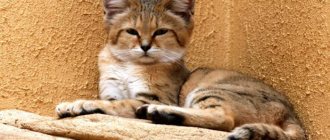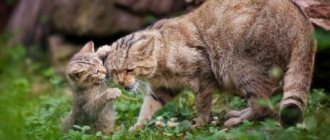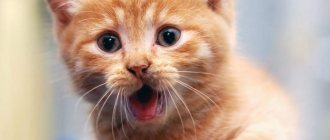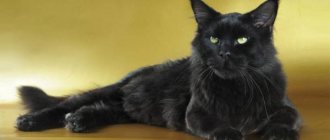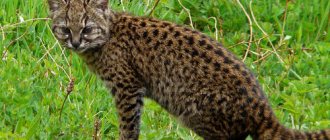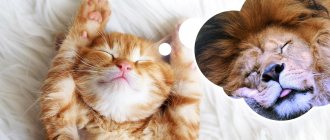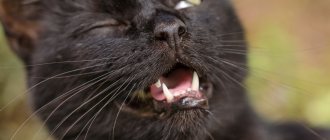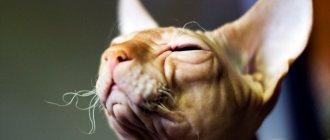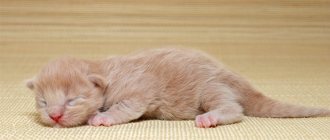Physical training
Jump
Cats are famous athletes. If nature wanted to create an ideal hunter, then it would certainly be cats. Well-built, flexible and graceful creatures, capable of real stunt tricks:
- Everyone knows about a cat's ability to land safely when falling from a height. An animal can twist in the air so as to fall on its paws and not be damaged even from a height of several floors. Curving in flight, the murka turns first its head, then its back and legs, almost at lightning speed, jumping straight to its feet. Moreover, the higher the height, the greater the chances of completing the landing successfully;
- Cats love heights. Thanks to their phenomenal sense of balance and excellent coordination, they become virtually invulnerable when climbing trees;
- The musculoskeletal system of the Murka has 250 bones and 517 muscles, and 10% of all bones are in the tail, which allows for excellent balance when running;
- Cats have fantastic vision. At a distance of sixty meters, the furry huntress is able to discern the slightest movement of the smallest rodent. Despite the fact that they don’t care about details. This explains the attempts of pets to catch a barely noticeable shadow or their own tail;
- Murki's sense of smell is 14 times greater than that of humans. And in addition to the nose, the “Jacobson’s organ” located on the palate helps the cat smell;
- A domestic cat can reach speeds of up to 48 km per hour, which exceeds the “human” record by as much as 5 km per hour;
- Murks are true hunters. Stray cats have caused the extinction of 33 animal species.
Does a cat's memory deteriorate with age?
As a cat ages, its memory may deteriorate. Brain aging leads to disorders similar to the symptoms of Alzheimer's disease in humans: poor spatial orientation, forgetting familiar and familiar things, reluctance to play and socialize, excessive appetite or lack thereof. The pet may even forget where its toilet and feeding bowl are. This is often accompanied by hearing and vision impairment.
You should not scold an old cat for a puddle in the corner or spilled food - she will experience stress and this will shorten her life even more.
There are no guaranteed ways to prevent such disorders in cats, because people have not yet learned how to deal with the problems of aging. But preventive measures include proper nutrition, normal weight of the animal and timely contact with a veterinarian for the treatment of chronic diseases.
My old cat Milka is already 18 years old. In the last year, she has developed many changes in behavior that indicate aging of the body: the desire to sleep in warm places most of the time, poor coordination of movements, and hearing impairment. But Milka’s memory is fine, which I’m incredibly happy about. She regularly goes to her litter box and knows well where her food and water bowls are. Milka doesn’t complain about her appetite either. The only brain disorder I see is when rules are ignored. She always knew that it was impossible to climb on the table and steal food (Milka is madly in love with sausages and boiled sausage). No, of course, she climbed and stole, but when she saw the man, she immediately ran and hid under the sofa. And now, if you find her on the table eating sausage, she will not pay any attention to us and will continue to gobble it up on both cheeks. Moreover, she can climb on the table in front of my eyes and start eating sausage right from my sandwich. We, of course, do not punish her for this, but simply remove her from the scene or treat her to sausage. We can say that Milka forgot (or simply does not consider it necessary to follow) some rules. But in general, for her 18 years, she is a great fellow!
Relationships with people
Scientists believe that the domestication of cats occurred more than three thousand years ago. The Egyptians were the first to allow cats into their homes. And the ancients can be understood: the animal not only perfectly guarded food warehouses, but also rose to the rank of a deity. But it is difficult to understand a cat: it is still not clear why an independent, freedom-loving animal needed to live under the same roof with a person. Perhaps the Murkas needed universal adoration? A lot of arguments can be given in favor of this version:
- Cats have an excellent sense of intonation in the human voice. When addressing your pet harshly, remember that he will definitely feel it. But a sense of self-superiority will not allow the cat to either admit or agree with your opinion.
Murki meow only “for people.” In the company of cats, furry ones use other sounds. For unintelligent people, animals “invented” hundreds of variants of “meow”, naively believing that a person distinguishes the meaning of each of them.
- The tail serves as a kind of mood indicator. Raised vertically and slightly quivering means the cat is happy to see you. Lifelessly drooping, most likely, indicates the Murka’s reluctance to have anything to do with you. If a pet swings its tail from side to side, then it is probably deciding on something: to enter the room or not to enter, to eat or sleep. Agree, this is a matter of utmost importance.
- Cats don't always rub against humans out of friendliness. Most often, the musk smells a foreign scent on “its” person and, with the help of its scent, tries to kill someone else’s. The same explains the habit of tailed animals to sleep on clothes and new things.
- Licking belongs to the same category of gestures. If the cat begins to actively “look after” you, most likely she considers you a representative of her “herd”. And you should smell like her and generally urgently need tenderness.
- A cat tramples its owner's stomach - there is a reason for pride. The person has pleased the pet in all its whims and can calmly enjoy the neighborhood. If the cat also nudged you with its forehead, rejoice, you’ve hit a real jackpot of furry emotions.
- Cats act as a sedative. In families where furry animals live, there are fewer quarrels and significantly lower stress levels.
- Most house murkas bury traces of their vital activity. But if the animal does not try to hide its “deeds,” it tells the person: “I am not afraid of you.” This is in some way a sign of aggression or competition.
All about cats cat and spring
For subscribers of MTS, Megafon, Beeline, Tele2: send an SMS message with the text Payment (space) UMKA (in capital letters) donation amount to the short number 3434 Example: Payment UMKA 100 to number 3434
The cost of the message is no more than 6.20 rubles including VAT (additionally charged to the donation amount).
Be careful! Send only the word PaymentUmka to the specified number, otherwise the funds will not be sent to help the fund’s pets.
After sending the first SMS, you will receive a message from the operator asking you to first confirm sending the first SMS, and then a message asking you to confirm the donation itself. Each operator uses its own special short number for this, so the confirmation request does not come from number 3434. According to the conditions of cellular operators, an sms with a confirmation code may be with the wording “Infotainment. This formulation is provided for by the Law “On Communications”.
All SMS confirmations are free!
Attention: The financial institution charges the fund a fee for its services in the amount of 10% of the amount of transfers, which proportionally reduces the amount sent to our pets.
Interesting facts about cats
Mouser
- In the Middle Ages, Europe was struck by a plague epidemic. One of the reasons for the spread of the disease was the mass extermination of the cat tribe and, as a consequence, an increase in the population of rats - carriers of the plague.
- In Britain, cats guard food warehouses, for which they receive payment in the form of food, and also after a few years they go into “retirement”. One furry guard annually saves about ten tons of grain.
- Cats allow themselves to sleep for 70% of their lives.
- Among furries, there are right-handers and left-handers. The former are more common among girls, and the latter among boys.
- A cat can give birth to about a hundred kittens over the course of its life.
- The Egyptians idolized cats so much that if a pet died, they shaved off their eyebrows as a sign of mourning.
- Men who have a cat in their house are considered luckier in their personal lives.
- Excessive love for cats is quite common and has even received a name - ailurophilia.
- Cats are inferior to dogs in terms of intelligence, but are capable of performing more complex tasks. The only condition for this is the cat’s personal interest in the matter.
- Most owners (95%) admit that they talk to their pets, every fifth cat is blow-dried after bathing, and every third owner is sure that their pet reads their thoughts.
- A black cat does not always portend trouble. In Britain and Australia, such an animal is associated with great luck.
- If the cat is unsure whether it will fit through the hole, it will use its whiskers to explore the area.
- When bringing dead mice into the house, the cat does not try to feed the owner. He tries to teach him to hunt and eat properly.
- Most purrs are not that afraid of water. They can easily go into the water and fish. Home bathing frightens pets only because they are forced into a basin.
- Cats hide when they are sick. A weakened body becomes easy prey for enemies, so the animal, feeling unwell, tries to take cover
If a cat gives a concert, it means spring has come
They asked the cat: - Tell me, is it true that in March. — What are you saying, March is no exception!
The first sign of spring is cat concerts, where not only traveling troupes, but also previously calm domestic animals strive to perform. Is there any way to pacify the ardor of your pet?
The only sure way to discourage cats from nighttime gatherings is to castrate them on time. This is best done at 6-8 months of age. Then the animal will easily survive this procedure and after a few days will completely forget about the operation and the existence of the opposite sex.
This is interesting: Couple gifts for lovers
This cannot be perceived as abuse of animals, if you do not intend to put kitten production on stream with the help of your pet, then a much greater crime is to force it to suffer from the March passion. In addition, naturalized animals are more affectionate, cleaner and friendlier than ordinary ones.
If the cat is a breeder, then you can cool its ardor with a cold shower. While wet, it will remain silent. Just don’t let him walk around in a draft, otherwise he’ll catch a cold.
The March cat is also not easy to pacify. Contrasex” will only delay her concerts for a while. As soon as the pills wear off, she will start screaming in a bad voice. The only sure way is to let her satisfy the cervical-vaginal reflex. It sounds, of course, indecent, but a month and a half of silence (until the next heat) is guaranteed.
The British have been using a pipette instead of a cat in such cases for 150 years. With the same success, you can use a pen cap, a thermometer, or any other suitable simulator.
As for “contrasex”, veterinarians are unanimous - this is a harmful drug. You can completely destroy a cat’s hormonal levels and undermine its health. But the worst effect it has on the offspring is that it often happens that subsequent litters are born with deformities.
© Olesya Nosova
"Komsomolskaya Pravda"
Fluffy record holders
The longest cat Stewie
The Guinness Book of Records also contains interesting facts about cats:
- The longest-living record holder was the cat Creme Puff from Texas. He lived for 38 years. And the oldest cat lives in Australia. She was born in 1977.
- The most famous mousetrapper was the cat Towser, who lived at the whiskey factory. During his 21 years of service, the furry hunter killed more than 28,000 rodents. A monument was erected in honor of the faithful “servant”.
- The most well-fed cat is considered to be Himmy, who weighed 21 kilograms and, thanks to a waist measuring 84 centimeters, was included in the Book of Records.
- The longest cat in the world was, of course, the Maine Coon. Its length was 123.19 cm
- The most notorious traveler is the cat Hamlet, who escaped from his carrier during a flight. Seven weeks later, the fugitive was found in the cabin. The distance that the cat “flew” was about 600 thousand km.
- The record for the largest number of cats living in one house was set in Canada. The couple Jack and Donna kept 689 pets at the same time.
- A cat named Mincho has set one of the strangest records. She climbed up a tree and didn’t get down... for six years. Living at the top, the pussy managed to give birth to kittens three times.
- A fertility record was set in Africa: a Persian cat gave birth to 14 kittens. In 1970, there was a cat in Britain who also gave birth to 19 kittens, but only 14 of them survived.
- Today, Mr Peebles is considered the smallest cat, weighing 1.35 kg with a height of just over 15 cm.
Pet behavior
In the spring, sometimes pets begin to behave a little unusually in an effort to find a partner. Representatives of cats are especially proactive during this period. With the onset of the long-awaited warmth, the streets and apartments are filled with their persistent serenades.
This spring surge of hormones is not accidental: most animals in nature are ready to reproduce only once a year; in this case, the offspring will be born in the summer, which gives newborns a better chance of survival and food.
Apartment mustaches
Of course, apartment pets are a little different from their wild counterparts: constant lighting and heating can provoke estrus and sexual activity more than once a year. As a rule, sexual maturity in females occurs at 5-6 months, and in males a little later - at 7-8 months. You shouldn’t think that dogs are alien to the passions of love; you probably know the expression “dog wedding season.”
In spring, man's best friend can become hyperactive and even aggressive. The ability to reproduce in dogs appears at approximately 8-12 months.
Mythical cats
Since ancient times, cats have been considered attributes of magical rituals. They were also credited with supernatural powers.
In Spanish-Jewish mythology, there is a belief that Lilith, Adam's first wife, was reincarnated as a vampire. She took the form of a black cat and drank human blood from sleeping children. Since then, there has been a superstition that cats “suck out” children's souls.
In ancient China, cats were believed to have the ability to exorcise evil spirits. These animals also personified Yin energy, femininity and darkness.
In Egyptian mythology, the sun god Ra is often represented as a red cat who swims along the underground Nile every night, fighting a serpent.
In Christianity, cats are endowed with negative traits. They are considered the embodiment of evil spirits and assistants of Satan. Beliefs say that witches flock to the Sabbath in the form of black cats.
Muslim legend says that it was a cat that saved the Prophet Muhammad from a snake attack. As a sign of gratitude, he stroked the cat, and stripes remained on its back - color. The Prophet is often called the "father of cats." There is also a legend that one day a cat fell asleep on the edge of his clothes. When leaving, he cut off the hem of his robe so as not to wake up the sleeping woman with his departure.
In Rus', cats were known back in the 7th century. Ancient legends mention the Bayun Cat, endowed with the gift of putting the enemy to sleep, thus sending death to him.
Vision
It is quite specific for a cat. She can see everything that is happening within a radius of 180⁰, that is, not only in front of her, but also from both sides at the same time. But at the same time, the cat cannot see what is too close to it.
When playing with a ball, animals pay more attention to the horizontal movement of the object. This is due to the instinct associated with catching rodents.
The sizes of the eyes of different breeds of animals differ and have their own characteristics. For example, a British cat. Interesting facts are that their eyes are too large compared to their body. In addition, they have one more feature - they do not have eyelashes. But it should be noted that these facts do not in any way affect the visual acuity itself.
The most common myth about cats is that they see perfectly in complete darkness. It must be said that this is an erroneous statement, since under such conditions they cannot recognize objects. Facts about British cats show that there must be at least some glimpses of light indoors for them to see perfectly.
Unlike dogs, which are mostly myopic, cats are farsighted, and their vision is naturally designed in such a way that when catching mice, they can freely observe several minks at the same time.
